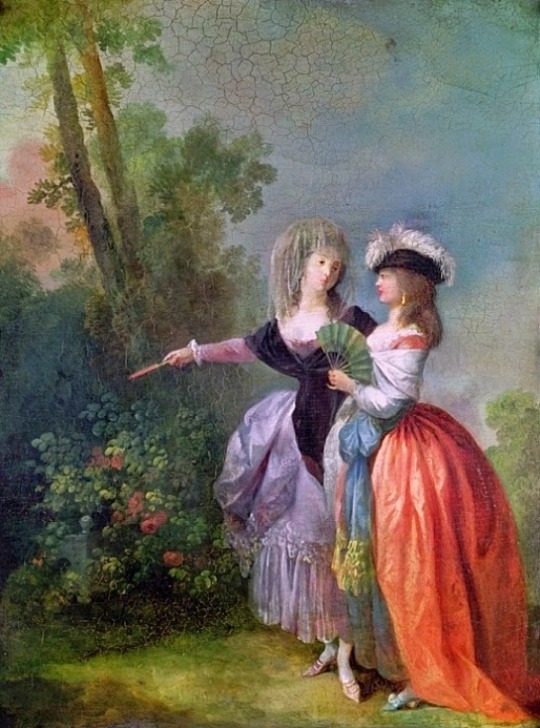#1780s France
Text
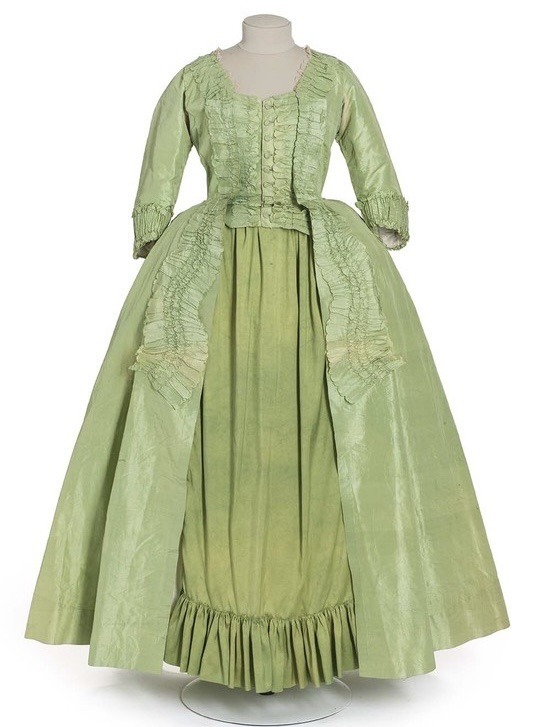


Pale Green Taffeta Dress, 1775-1785, French.
Musée des Arts Décoratifs Paris.
#womenswear#extant garments#dress#silk#green#18th century#1775#1770s#1780s#1770s dress#1780s dress#1770s france#1780s France#mad paris#musée des arts décoratifs paris#France#French#reign: louis xvi#1776#1777#1778#1779#1780#1781#1782#1783#1784#1785#1770s extant garment#1780s extant garment
260 notes
·
View notes
Text


Robe à la française
1750s; Altered 1780s & Late 19th Century
France & England
The ensemble was probably made as a sack and petticoat in the 1750s. In the 1780s, the sack was updated in style. A waist seam was probably added, the skirts reconfigured, and sleeve ruffles removed. The half-stomachers were added at this time and the bodice fronts relined. The back lacing was reconfigured and more eyelets worked.
The ensemble was altered for fancy dress in the late 19th century. Hooks and eyes were added to the bodice stomacher fronts and machine-lace ruffles to the sleeves. The petticoat may have been unpicked at this point.
The petticoat was gathered onto a cotton band after acquisition for Museum display. (V&A)
Victoria & Albert Museum (Accession Number: CIRC.157-1920)
#robe a la francaise#fancy dress#fashion history#historical fashion#1750s#1780s#19th century#georgian#victorian#france#england#v and a#v and a museum#popular
1K notes
·
View notes
Text

Planche 1, Cabinet des Modes, May 15th 1786, Bibliothèque Nationale Française.
This plate has a LONG description, and here's a (shortened) rough translation of the description:
We can say it is no longer desirable for women to dress with great adornment (...) and these fashions are no longer made but for ceremonial gatherings, weddings, formal balls, large meals, which take place in very small numbers. This justifies us to not have often representations of these garments (...), nevertheless since they re sometimes worn, we show them in plates 1 and 2.
In plate 1 we can clearly see that we no longer wear the big paniers and even in the most adornment, the fashions have been simplified (except, of course, the court clothes, which do not vary much and can be traces to the clothes of our fathers) (...).
The woman in Plate 1 wears a blue robe à la Turque. The petticoat is of the same fabric and colour, the sleeves are made of white gros-de-Naples or another white fabric. The trim of the dress is in white crepe in the shape of rosettes, and in the middle of each is bouquet of artificial roses. The skirt of also decorated with white crepe and rosettes similar to the dress. The cuffs attached to the sleeves are made of cut white gauze. The throat is covered with a gauze fichu, tied at the front with a rainbow ribbon bow, she wears white leather gloves, and a fan. The head is covered with a bonnet also tied with a rainbow ribbon and topped with a garland of artificial roses. The ribbon forms a large bow at the back and holds a white crepe veil that falls almost to the waist, and on top of the bonnet rises a set of feathers: two rose, two blue, one white, and one green. The hairstyle has light curls along the entire front of the head, her hair is pulled up at the back in a flat bun, and two large curls on each side fall down her length. Her shoes are blue to match the colour of the dress, and are adorned with rainbow ribbon.
I found many funny things in this description, like that the magazine writers thought in 1786 that this look was simple, the concept of rainbow ribbon (ruban à l'Arc-en-Ciel) that seems to simply be a ribbon in colourful stripes, and the size and complexity of that bonnet. How about you? Please let me know in the comments or reblog tags, what is your favorite part of this outfit, or even if you'd like to reproduce it.
Also, the plate 2, that is a men's outfit, will be posted soon :)
#18th century#18th century fashion#cabinet des modes#1780s#1786#france#womenswear#blue#blue womenswear#fashion plate
62 notes
·
View notes
Photo
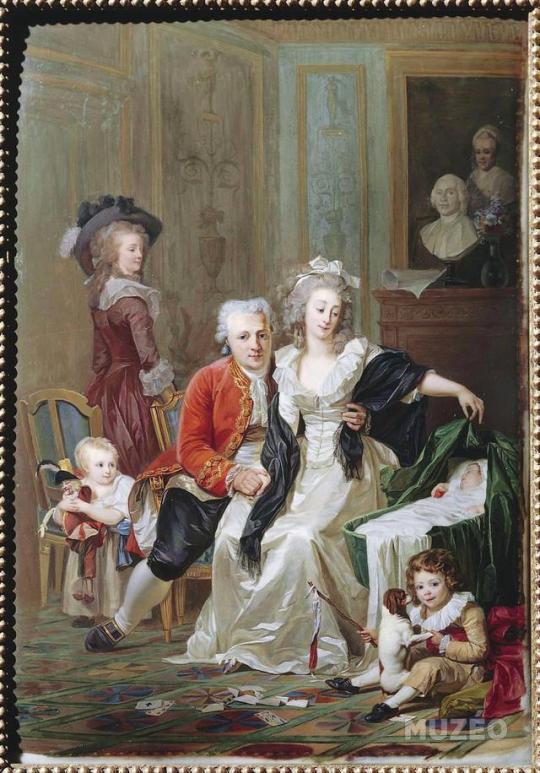
Mégret de Sérilly and his family by Jacques Thouron, 1787
69 notes
·
View notes
Text

Napoleon gets dancing lessons in 1811 and he apparently leaps like a goat 🤭
#cuteeee#the dancing empire#Jean- Etienne Despréaux#Despréaux#Napoleon#napoleon bonaparte#Marie Louise#book#1811#dancing#books: The Lure of Perfection: Fashion and Ballet 1780-1830: Bennahum Judith#napoleonic era#napoleonic#first french empire#19th century#1800s#history#french empire#France#french history
52 notes
·
View notes
Text
The Chevalier d'Éon (1728-1810) was raised in France as the male heir to the Beaumont family. The decorated soldier dressed as a man to serve as a captain of Dragoons, and as a woman named Lia de Beaumont to spy for France on Russia and England. A master fencer, the Chevalier is shown here on the right in a celebrated match against Chevalier de St Georges. This was painted by Alexandre-Auguste Robineau c.1787.

"Normal Women: 900 Years of Making History" - Philippa Gregory
#book quotes#normal women#philippa gregory#nonfiction#chevalier d'eon#france#beaumont#soldier#dragoons#captain#lia de beaumont#spy#russia#england#fencing#chevalier de saint georges#alexandre auguste robineau#80s#1780s#18th century
5 notes
·
View notes
Text
My problem with shows and movies set in modern time is that if i wanted to see modern time i’d look out the window. i have the blinds shut. I do not want to see. Show me a medieval castle.
#partially about the sandman#period dramas#tv shows#netflix#pjo is an exception i hope i won’t have to explain#all these netflix trash shows#like stop#but i’d watch first kill if it was set in 1824 scandinavia#or 1780’s france#or 1600’s england
5 notes
·
View notes
Text
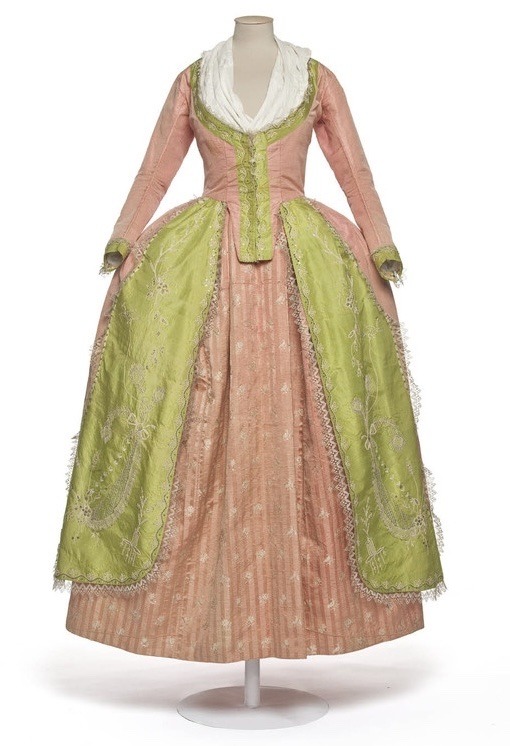


Pink and Green Robe à la Polonaise, 1780-1785, French.
Musée des Arts Décoratifs Paris.
#musée des arts décoratifs paris#mad paris#womenswear#extant garments#dress#silk#18th century#robe à la polonaise#french#France#1780s#1780s dress#1780s France#reign: louis xvi#pink#green#1780#1781#1782#1783#1784#1785#1780s extant garment
183 notes
·
View notes
Text
According to one critic, 75 percent of Lyon’s silk workers lost their jobs in the 1780s because the queen’s preference for foreign fabrics caused French silks to fall out of fashion.
0 notes
Photo
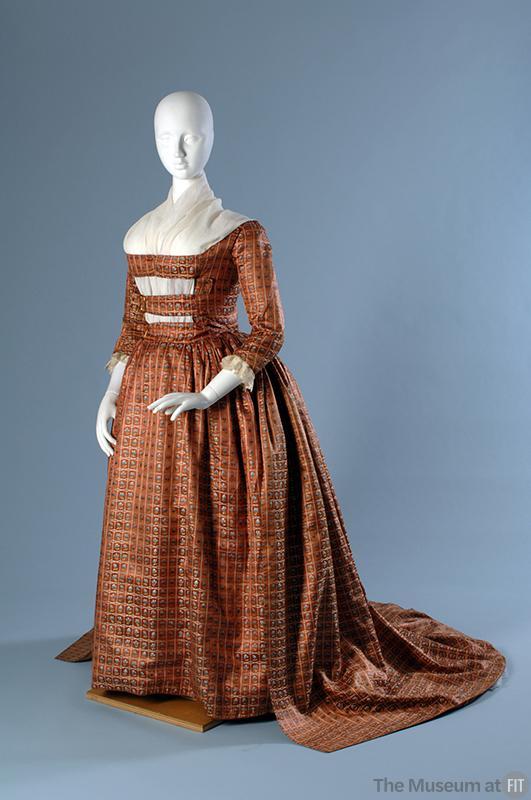

Robe à l'anglaise
c.1785
France
Museum at FIT (Object number: 2006.56.1)
#robe a l'anglaise#fashion history#historical fashion#1780s#rococo era#18th century#ancien régime#ancien regime#1785#orange#floral#flower print#france#silk#satin#museum at fit
357 notes
·
View notes
Video
Antique safe made in France around ~1780 / 1810. With three keys and a combination of ordered switches
35K notes
·
View notes
Text
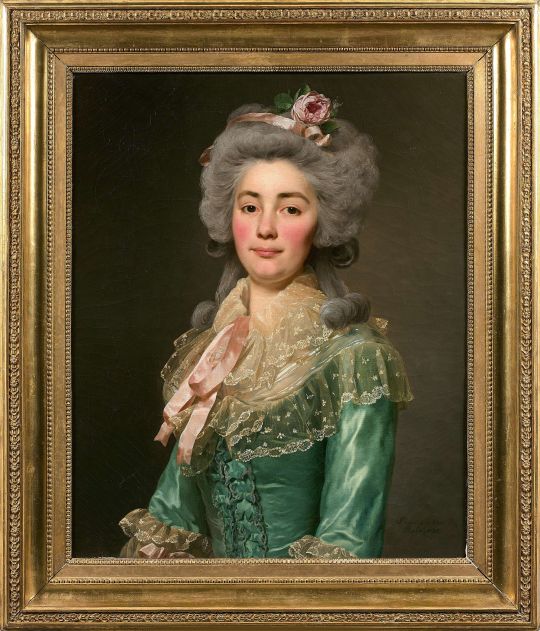
Portrait of a lady presumed to be Mademoiselle de Fontenay by Alexander Roslin, 1784
104 notes
·
View notes
Text

I’m in love with this embroidery detail
Waistcoat, France, circa 1785-95
White silk waistcoat with high stand collar and straight hem edge. Very deep border at front edges of a curving, flowering vine. At the bottom, embroidered figures in classical dress stand in front of a stone balustrade with urns of flowers and fruit trees. The figures represent Dido and Aeneas, from the opera by Piccini and Marmontel, produced in 1785. The figure of Dido is after a drawing by Jean-Michel Moreau le Jeune for the costume worn by Mlle. de Saint-Huberty. In twenty-five colors of silk.
#waistcoat#France#1780s#1790s#18th century#1700s#art#embroidery#fashion#pretty#French#French fashion#rococo#baroque#french art#history of fashion#sewing#clothing#men’s fashion#menswear#European art#beautiful#dido#Aeneas#Jean-Michel Moreau le Jeune#Mlle. de Saint-Huberty#mythology#roman mythology#Roman#detail
15 notes
·
View notes
Note
How did cotton win over linen anyway?
In short, colonialism, slavery and the industrial revolution. In length:
Cotton doesn't grow in Europe so before the Modern Era, cotton was rare and used in small quantities for specific purposes (lining doublets for example). The thing with cotton is, that's it can be printed with dye very easily. The colors are bright and they don't fade easily. With wool and silk fabrics, which were the more traditional fabrics for outer wear in Europe (silk for upper classes of course), patterns usually needed to be embroidered or woven to the cloth to last, which was very expensive. Wool is extremely hard to print to anything detailed that would stay even with modern technology. Silk can be printed easily today with screen printing, but before late 18th century the technique wasn't known in western world (it was invented in China a millenium ago) and the available methods didn't yeld good results.
So when in the late 17th century European trading companies were establishing trading posts in India, a huge producer of cotton fabrics, suddenly cotton was much more available in Europe. Indian calico cotton, which was sturdy and cheap and was painted or printed with colorful and intricate floral patters, chintz, especially caught on and became very fashionable. The popular Orientalism of the time also contributed to it becoming fasionable, chintz was seen as "exotic" and therefore appealing.
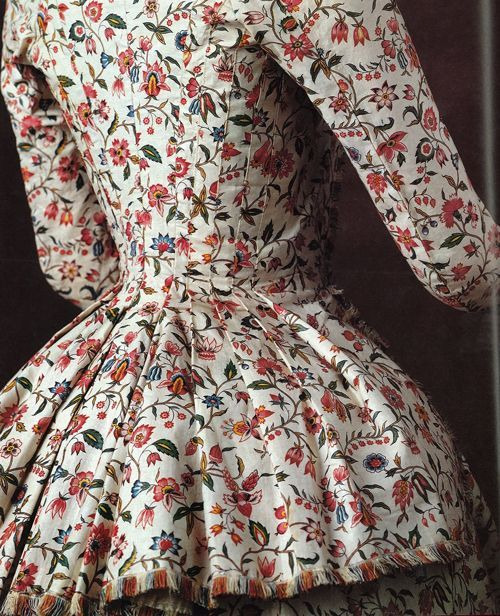
Here's a typical calico jacket from late 18th century. The ones in European markets often had white background, but red background was also fairly common.
The problem with this was that this was not great for the business of the European fabric producers, especially silk producers in France and wool producers in England, who before were dominating the European textile market and didn't like that they now had competition. So European countries imposed trade restrictions for Indian cotton, England banning cotton almost fully in 1721. Since the introduction of Indian cottons, there had been attempts to recreate it in Europe with little success. They didn't have nearly advanced enough fabric printing and cotton weaving techniques to match the level of Indian calico. Cotton trade with India didn't end though. The European trading companies would export Indian cottons to West African market to fund the trans-Atlantic slave trade that was growing quickly. European cottons were also imported to Africa. At first they didn't have great demand as they were so lacking compared to Indian cotton, but by the mid 1700s quality of English cotton had improved enough to be competitive.
Inventions in industrial textile machinery, specifically spinning jenny in 1780s and water frame in 1770s, would finally give England the advantages they needed to conquer the cotton market. These inventions allowed producing very cheap but good quality cotton and fabric printing, which would finally produce decent imitations of Indian calico in large quantities. Around the same time in mid 1700s, The East Indian Company had taken over Bengal and soon following most of the Indian sub-continent, effectively putting it under British colonial rule (but with a corporate rule dystopian twist). So when industrialized English cotton took over the market, The East India Company would suppress Indian textile industry to utilize Indian raw cotton production for English textile industry and then import cotton textiles back to India. In 1750s India's exports were mainly fine cotton and silk, but during the next century Indian export would become mostly raw materials. They effectively de-industrialized India to industrialize England further.
India, most notably Bengal area, had been an international textile hub for millennia, producing the finest cottons and silks with extremely advance techniques. Loosing cotton textile industry devastated Indian local economies and eradicated many traditional textile craft skills. Perhaps the most glaring example is that of Dhaka muslin. Named after the city in Bengal it was produced in, it was extremely fine and thin cotton requiring very complicated and time consuming spinning process, painstakingly meticulous hand-weaving process and a very specific breed of cotton. It was basically transparent as seen depicted in this Mughal painting from early 17th century.
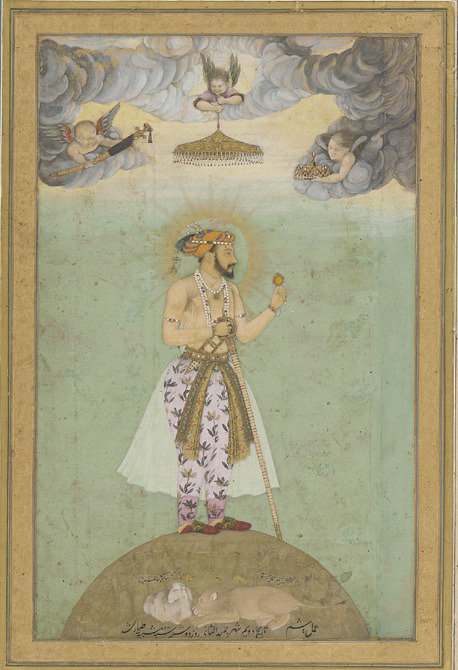
It was used by e.g. the ancient Greeks, Mughal emperors and, while the methods and it's production was systematically being destroyed by the British to squash competition, it became super fashionable in Europe. It was extremely expensive, even more so than silk, which is probably why it became so popular among the rich. In 1780s Marie Antoinette famously and scandalously wore chemise a la reine made from multiple layers of Dhaka muslin. In 1790s, when the empire silhouette took over, it became even more popular, continuing to the very early 1800s, till Dhaka muslin production fully collapsed and the knowledge and skill to produce it were lost. But earlier this year, after years lasting research to revive the Dhaka muslin funded by Bangladeshi government, they actually recreated it after finding the right right cotton plant and gathering spinners and weavers skilled in traditional craft to train with it. (It's super cool and I'm making a whole post about it (it has been in the making for months now) so I won't extend this post more.)


Marie Antoinette in the famous painting with wearing Dhaka muslin in 1783, and empress Joséphine Bonaparte in 1801 also wearing Dhaka muslin.
While the trans-Atlantic slave trade was partly funded by the cotton trade and industrial English cotton, the slave trade would also be used to bolster the emerging English cotton industry by forcing African slaves to work in the cotton plantations of Southern US. This produced even more (and cheaper (again slave labor)) raw material, which allowed the quick upward scaling of the cotton factories in Britain. Cotton was what really kicked off the industrial revolution, and it started in England, because they colonized their biggest competitor India and therefore were able to take hold of the whole cotton market and fund rapid industrialization.
Eventually the availability of cotton, increase in ready-made clothing and the luxurious reputation of cotton lead to cotton underwear replacing linen underwear (and eventually sheets) (the far superior option for the reasons I talked about here) in early Victorian Era. Before Victorian era underwear was very practical, just simple rectangles and triangles sewn together. It was just meant to protect the outer clothing and the skin, and it wasn't seen anyway, so why put the relatively scarce resources into making it pretty? Well, by the mid 1800s England was basically fully industrialized and resource were not scarce anymore. Middle class was increasing during the Victorian Era and, after the hard won battles of the workers movement, the conditions of workers was improving a bit. That combined with decrease in prices of clothing, most people were able to partake in fashion. This of course led to the upper classes finding new ways to separate themselves from lower classes. One of these things was getting fancy underwear. Fine cotton kept the fancy reputation it had gained first as an exotic new commodity in late 17th century and then in Regency Era as the extremely expensive fabric of queens and empresses. Cotton also is softer than linen, and therefore was seen as more luxurious against skin. So cotton shifts became the fancier shifts. At the same time cotton drawers were becoming common additional underwear for women.
It wouldn't stay as an upper class thing, because as said cotton was cheap and available. Ready-made clothing also helped spread the fancier cotton underwear, as then you could buy fairly cheaply pretty underwear and you didn't even have to put extra effort into it's decoration. At the same time cotton industry was massive and powerful and very much eager to promote cotton underwear as it would make a very steady and long lasting demand for cotton.
In conclusion, cotton has a dark and bloody history and it didn't become the standard underwear fabric for very good reasons.
Here's couple of excellent sources regarding the history of cotton industry:
The European Response to Indian Cottons, Prasannan Parthasarathi
INDIAN COTTON MILLS AND THE BRITISH ECONOMIC POLICY, 1854-1894, Rajib Lochan Sahoo
#i have fixed the wording in the beginning so it doesn't sound like i'm saying cotton in general dyed better than wool or silk#answers#fashion history#historical fashion#history#textile history#dress history#historical clothing#indian history#colonial history#indian textiles#cotton#slavery
2K notes
·
View notes
Text

The devil takes flight. France. 1780s.
Gallica
234 notes
·
View notes
